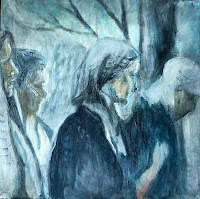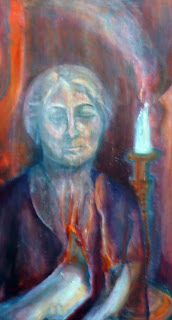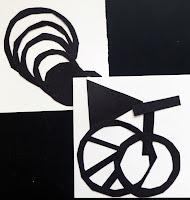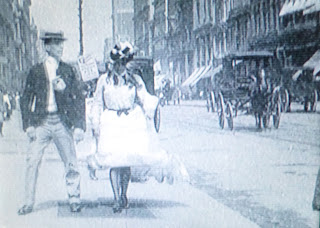I often am surprised by what I don’t know about Judaism. I am especially intrigued with how certain texts relate to creativity. The Artists' Lab is on the theme of Text/Context/Subtext. I hadn’t thought of Jewish texts as a catalyst for my artwork and am pleased to discover they can function in that way. I come out of sessions of the Artists' Lab* with all of my synapses firing.
As we were in the midst of Passover last week, the Jewish Artists’ Lab touched on topics related to the Exodus from Egypt.The rabbi began the session asking if we felt enslaved or liberated by our artwork. I thought of when I have a painting that isn’t working and need to let it go to start anew. I often feel a sense of enslavement, hesitant to paint over it, yet not satisfied with the result. Others talked of that mix of feelings when one starts an artwork, both anticipation and also a sense of obligation to one’s work.
The focus of the session was on "Ruah" which means “breath”. Ruah is spiritual and creative energy, the breath of God. We began with a passage from Exodus 6:9 that talks of when Moses first tells the Israelites that he will deliver them from bondage. The passage says they would not listen to him because of m’kotzeir ruah (literally shortness of breath) and cruel bondage.
We talked about how oppression can create such distress that one can’t hear or perhaps imagine a different life. I found myself thinking of Maslow’s hierarchy of needs. When one is seeking to meet basic needs, concepts of imagination, spirituality or creativity may be of lesser focus.
We played with words and their meanings. "Inspiration" as filled with creativity, the breath of God, derived from the Latin "spirare" which means to breath. "Expiration", emptied of breath as when we expire. I love the layers of meaning embedded in words, metaphors hiding in plain sight.
In addition to the passage itself, the rabbi also shared responses through time, from Rashi in 11th century France, Sforno in 15th century Italy to Hirsch in 19th century Germany. There is a long Jewish tradition of sharing commentary across time and geography. Time indeed compresses as we join around the table.
We turned to a more contemporary response, Aviva Zornberg in The Particulars of Rapture. She posits that “in order to hear we need to clear ourselves of obstruction, open ourselves: for that reason we read the narrative of the Exodus, culminating in the Song of the Sea, before reading the shema prayer (which means “hear”). ” The Exodus prepares us to move past “shortness of breath”, past oppression and obstruction, to be able to hear again as represented by the Shema.
But what of Ruah as it relates to creating? In fact the first use of the word is in Genesis 1:1-2 where God creates the world. The passage translates to “In the beginning of God’s creating the heavens and the earth, when the earth was astonishingly empty, with darkness upon the face of the deep, and ruah elohim hovered upon the surface of the waters, God said, “let there be light”.” Ruah exists even before that first act of creation.
I thought about the relevance of these passages to the creative process, the idea of clearing ourselves of obstruction, breathing deeply in order to welcome ruah into our life, enabling us to hear and create. Perhaps it is not a coincidence that so many of my ideas come to me in child’s pose in my yoga class as we practice breathing.
Also in this vein we discussed Counting the Omer, something with which I had not been familiar. This is a verbal counting of the 49 days between Passover and Shavuot. The purpose of this count is to remind us of the link between Exodus which Passover commemorates and the giving of the Torah which is the focus of Shavuot. The Kaballah focuses upon these 49 days as a period of spiritual growth preparing for the acceptance of the Torah, again a clearing out of obstructions, making room for Ruah.
Breath and smell also bear a relationship. The Havdallah ceremony entails smelling a blend of spices to close out the Sabbath, bringing us back to the work-a-day world. I find myself thinking that many of our sessions have focused on the senses, seeing, hearing, smelling. We use our senses to let the world in and in turn to create.
In each session the first half is discussion, the second an exercise. Our subsequent exercise was two-fold, one a yoga breathing and visualization exercise and the second one with words. The word exercise, which is a little easier to capture in this medium, focused on writing our story in six words, a distillation that challenges an essayist like myself. My short-lived attempt at Twitter ended in frustration at its word limit. I met with a little more success in this endeavor. I’ve written in this blog of setting the table to invite surprises into our life so I came up with two six word stories to reflect my life themes: "Solving Puzzles, Telling Stories, Inviting Surprises" or “Setting the Table for Unexpected Surprises”.
So let me divert a little from the Artists’ Lab and give you an example of that. As a planner by nature, I can plan too much and not leave enough room for the unexpected. Part of me likes to know what is coming even though I know surprises are the wonderful gifts that have moved my life forward. I’ve learned how to set the table, create circumstances that invite surprises in while still preserving some structure. Years ago I used to take my mother on trips to Europe. I always would reserve a hotel in our first city and our last, but in between we played it by ear. I think you would call that “planned uncertainty”. We’d arrive by train at the station and book a random hotel. That way we had flexibility in our schedule and an opportunity for surprises while still preserving the certainty of a hotel upon landing or before departing. Had I planned out every detail I would have known exactly where I was going and when, but not the wonderful detours of discovery.
Ruah and surprises, perhaps there is a relationship. Sometimes excessive planning enslaves us, blocking us from hearing that quiet voice inside of ourselves, obstructing us from creativity and the chance discovery. Opening ourselves up to the unknown, the unplanned, the breath of God, isn’t that the very essence of creativity?










